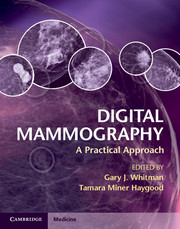Book contents
- Frontmatter
- Contents
- List of contributors
- Preface
- Acknowledgments
- Chapter 1 Detectors for digital mammography
- Chapter 2 Image acquisition
- Chapter 3 Preparing digital mammography images for interpretation
- Chapter 4 Image display and visualization in digital mammography
- Chapter 5 PACS, storage, and archiving
- Chapter 6 Interpretation of digital screening mammography
- Chapter 7 Efficacy of digital screening mammography
- Chapter 8 Artifacts in digital mammography
- Chapter 9 Mobile digital mammography
- Chapter 10 Procedures with digital mammography
- Chapter 11 Digital breast tomosynthesis
- Chapter 12 Breast computed tomography
- Chapter 13 Cases
- Chapter 14 Comparison of commercially available systems
- Index
- References
Chapter 9 - Mobile digital mammography
Published online by Cambridge University Press: 05 December 2012
- Frontmatter
- Contents
- List of contributors
- Preface
- Acknowledgments
- Chapter 1 Detectors for digital mammography
- Chapter 2 Image acquisition
- Chapter 3 Preparing digital mammography images for interpretation
- Chapter 4 Image display and visualization in digital mammography
- Chapter 5 PACS, storage, and archiving
- Chapter 6 Interpretation of digital screening mammography
- Chapter 7 Efficacy of digital screening mammography
- Chapter 8 Artifacts in digital mammography
- Chapter 9 Mobile digital mammography
- Chapter 10 Procedures with digital mammography
- Chapter 11 Digital breast tomosynthesis
- Chapter 12 Breast computed tomography
- Chapter 13 Cases
- Chapter 14 Comparison of commercially available systems
- Index
- References
Summary
Introduction
Breast cancer is currently the most common malignancy in American women. Recently, breast cancer has become the second leading cause of death in women after lung cancer. But it is a distant second. The rather remarkable difference in mortality rate comparing breast cancer to lung cancer is related to our ability to detect breast cancer at an early and more readily curable stage. Prior to the emergence of modern mammography, beginning in the early 1960s, the five-year survival rate for breast cancer was on the order of 45% [1]. Mortality reductions in breast cancer began to emerge in the late 1960s and early 1970s when the results of two major randomized controlled trials were reported. These trials were the HIP study in New York City [2] and the Swedish Two County Trial led by Dr. Laszlo Tabár [3]. The HIP study reported a 33% mortality reduction over a five-year follow-up period between women who had both screening mammography and clinical examination on a regular basis and those who did not. The Swedish study, which was started in the mid-1970s and continues today, has demonstrated a steadily increasing survival advantage, now on the order of 50%, for women who participate in regular screening mammography.
Evolution of mammographic technology
In the early days of mammography, no particular attention was given to providing specialized imaging equipment specifically designed to interrogate breast tissue. Standard overhead x-ray tubes were employed using the typical 40-inch tube-film distance commonly used for imaging the body. Breast compression was rudimentary at best, and the image receptor was nothing more than a single emulsion film in a cardboard cassette. This system was improved upon by Robert Egan, who recognized the limitations of mammography at that time. He introduced the “double film pack.” This was not much more than two separate pieces of x-ray film in the same cassette with differing speeds or contrast curves. In the late 1960s, x-ray tubes were introduced which used molybdenum targets and filters [4]. This produced substantially better image contrast, particularly in women with fatty breasts. In the 1970s, grids specifically designed for mammography began to appear, and in an attempt to improve film-screen contact, the DuPont Company developed a vacuum cassette. In this device, the x-ray screen and the film were more or less sucked together by applying vacuum to a valve on the outside of the cassette.
- Type
- Chapter
- Information
- Digital MammographyA Practical Approach, pp. 85 - 95Publisher: Cambridge University PressPrint publication year: 2012

